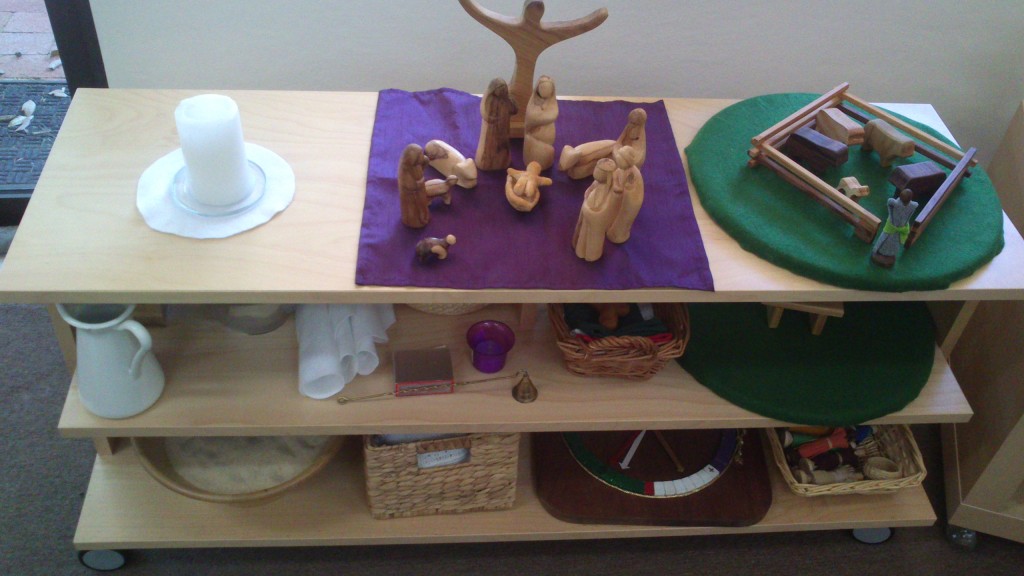‘Godly Play’ – a fresh approach to wondering.
At the end of last year I (Penny Reeve) decided to attend a training course to become an accredited Godly Play Storyteller and Door-person. It was a quick decision – I’d only heard about the course a couple of weeks before – but it felt too important to miss. So I juggled child minding needs and booked myself in.

The focal point in a Godly Play room is always the ‘Holy Family’, which
includes a figure representing the risen Christ.
So, what is Godly Play? Well, I describe it as ‘Montessori Style Bible Teaching’. Researched and written by Jerome W. Berryman in the USA it differs fundamentally with the current trends in teaching the Bible to children. Rather than telling kids the answers, it encourages them to wonder (“I wonder what part of this story you liked the best?” “I wonder what was the most important part?” etc) Rather than high energy entertainment, it cherishes the quiet, sacred skill of oral storytelling with minimalistic materials (that’s the Montessori element coming out.) Rather than pre-prepared crafts or worksheets, it encourages freedom of response to the story of the day. In a full Godly Play experience there is time to ‘get ready’, listen to a story, respond creatively, ‘feast’, fellowship and pray. It’s a method of Bible teaching that recognises a child’s spirituality, but that is also incredibly powerful for adults.
During our training we were exposed to several stories (Bible narratives, parables and liturgical explanations) and invited to respond authentically. We practiced telling stories ourselves and performing the role of the caring and attentive door-person who welcomes each person into the ‘Godly Play’ environment. It was an exceptionally sacred time where each participant felt they grew in their understanding of who God is and the wonder of his word.
Now that I have tasted this style of sharing faith stories I find myself wanting to do so more and more. Although I am not in an active children’s ministry or educational role at present, I’ve begun making and sourcing bits and pieces of material so that I can share the precious stories of faith, Godly Play style, with my family. We’ve reached the stage now where almost every second day my three year old will say: ‘Tell me the Holy Family’ (the nativity story). And each time he will sit and listen without wriggling or distraction, and then wonder in a way that is uniquely his about this ‘Christ Child’ he is learning to love. It is precious and certainly worth the juggling of last year.
No, I wouldn’t describe Godly Play as a complete package. There is still room in children’s ministry and education for lively discussion groups and rowdy games. I still use my favourite children’s Bibles to explain the story of God. But as a quiet, sacred method for allowing children to explore and learn I’m glad I stumbled across Godly Play, and know I’ll be finding more ways to use it in the future.
You can learn more about Godly Play here.
Have you used Godly Play before? What was your experience of it either as an adult, or with children?

Yes, I use Godly Play. I trained about 10 years ago I think ~ several years ago anyway! I love it. And yes, I agree there’s still room in children’s ministry for the lively discussion and games, but I do love the “safe” place Godly Play provides children to talk about their answers.
As for using it, because I’m focused in on the telling I can’t tell how the children are responding to the story (that’s the bit I don’t like, but I always talk to the other adult there (the doorkeeper) to see how they responded during the story time. They are usually captivated by the story.
I like the time for sharing thoughts afterwards, though you do have to be prepared for some of the things they may reveal, and how to handle it. When I do the Easter story the “I wonder what makes you sad?” question can reveal some deep hurts.
Thanks for your comments, Wendy. I also find the focus on the story a little challenge, especially as I normally use a lot of eye contact with children when I am storytelling. In my ‘at home’ setting where I’ve been practicing the stories with my family there is no door-person. So I am trusting the process (and the Lord) with a lot of that side of things.
i love that you’ve used this at home. I did the course in 2013 to share it with my children too and have found their response surprisingly focused for young ones